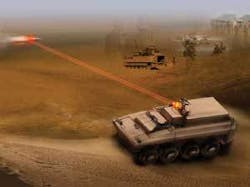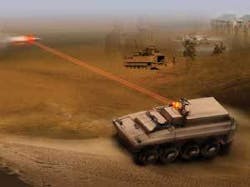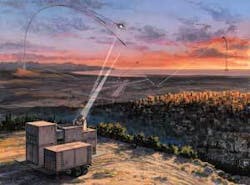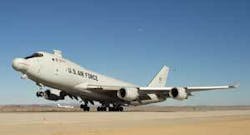Laser weapons are getting closer to reality
By John McHale
Laser weapons are not as far away as the average citizen may think. U.S. Department of Defense experts are close to fielding the Airborne Laser (ABL) for missile defense and several other high-energy laser weapons programs received new funding this year.
Many of these programs that expect to bring laser weaponry into the hands of the warfighter on the ground involve solid-state laser technology.
The U.S. Army is funding the Joint High Power Solid-State Laser (JHPSSL) program to develop “military-grade,” solid-state laser technology that is expected to pave the way for the U.S. military to incorporate high-energy laser systems across all services, including ships, manned and unmanned aircraft, and ground vehicles.
Much of the JHPPSL research is conducted through the U.S. Air Force Research Laboratory’s Directed Energy Directorate at Kirtland Air Force Base, N.M.
In a related effort to investigate the effect of a high-energy laser in air-to-air combat, AFRL is performing a Tactical High-Energy Laser Utility Study (THELUS) in a virtual simulation environment. As a follow-on to a previous test, AFRL scientists performed simulated tests of air-to-air engagement involving two aircraft versus four. For the test effort, six tactically rated pilots divided into two teams: red and blue. To acquire baseline data, the researchers first provided both teams with identical weapons and sensors; they later modified the blue team configuration to include the directed-energy weapon (DEW), while the red team retained its conventional weaponry.
To determine the DEW’s effects on the mission, the researchers altered two distinct characteristics of the DEW throughout the test scenarios, changing the maximum sensor range (which determines how far pilots can see with the DEW) and the thermal budget (which determines how long pilots can fire continuously). The testing determined both survivability and mission success under the altered conditions. Pilots using the DEW were able to survive longer despite altered conditions. Furthermore, DEW utilization resulted in a greater probability of at least one pilot surviving the mission, AFRL offices say.
The funding for this laser technology is increasing but not near the levels of the Airborne Laser.
Airborne Laser
The ABL began flight tests in late 2006 with the rollout of the ABL aircraft from a modification facility in Wichita, Kan., earlier this fall during a ceremony marking major program achievements on several fronts.
“The revolutionary technology … with the Airborne Laser has the potential to change the very nature of warfare,” said Lt. General Henry “Trey” Obering, Missile Defense Agency director, during the roll out.
The ceremony highlighted various accomplishments. The Airborne Laser team in Wichita fully integrated the Lockheed Martin-designed beam-control/fire-control system inside the ABL aircraft, a modified Boeing 747-400F. Two solid-state illuminator lasers, which are part of the beam-control device, and a surrogate high-energy laser were installed and fired repeatedly at a simulated ballistic missile target. The track illuminator laser is designed to track a target, while the beacon illuminator laser is intended to measure atmospheric turbulence that the high-energy chemical laser would encounter in its path to the target. During the ground tests, results from the illuminator firings were fed back to ABL, allowing the surrogate high-energy laser to shoot down a simulated target. The program achieved most of the objectives of the ground tests and expects to satisfy the remaining ones in the coming months.
In California, Northrop Grumman engineers finished ground-testing the optics that will shape the high-energy laser beam and direct it from the laser to the beam-control/fire-control system. The optics underwent inspection and refurbishment after the laser achieved lethal power and run-times in a ground laboratory in December 2005.
Boeing is the prime contractor for ABL, which will provide a speed-of-light capability to destroy all classes of ballistic missiles in their boost phase of flight. Boeing provides the modified aircraft and the battle-management system and is the overall systems integrator. ABL partners are Northrop Grumman, which supplies the high-energy laser and the beacon illuminator laser, and Lockheed Martin, which provides the nose-mounted turret in addition to the beam-control/fire-control system.
Laser Gunship Program
Boeing in St. Louis has begun flight testing for the Advanced Tactical Laser (ATL) Advanced Concept Technology Demonstration (ACTD) program and has generated “first light” of ATL’s high-energy chemical laser in ground tests, achieving two key milestones in the laser gunship development effort.
During the “low-power” flight tests, a low-power, solid-state laser will serve as a surrogate for ATL’s high-power chemical laser. To prepare for the tests, the ATL aircraft, a C-130H from the U.S. Air Force 46th Test Wing, was outfitted with flight demonstration hardware at Crestview Aerospace Corp. in Crestview, Fla. The hardware includes the beam director and optical control bench, which will direct the laser beam to its target; weapon system consoles, which will display high-resolution imagery and enable the tracking of targets; and sensors.
Boeing fired the high-energy chemical laser for the first time in ground tests early in Fall 2006-an achievement known as “first light.” By 2007, Boeing will install the device on the aircraft and fire it in-flight at mission-representative ground targets to demonstrate the military utility of high energy-lasers. The test team will fire the laser through a rotating turret that extends through an existing 50-inch-diameter hole in the aircraft’s belly.
Boeing is developing ATL for the U.S. Department of Defense through an ACTD program.
ATL will destroy, damage or disable targets with little to no collateral damage, supporting missions on the battlefield and in urban operations. ATL will produce scaleable effects, meaning the weapon operator will be able to select the degree and nature of the damage done to a target by choosing a specific aimpoint and laser shot duration. For example, targeting the fuel tank of a vehicle could result in total destruction of the vehicle, while targeting a tire might result in the vehicle stopping without injury to the driver.
Boeing’s Advanced Tactical Laser industry team includes L-3 Communications/Brashear, which made the laser turret, and HYTEC Inc., which made various structural elements of the weapon system.
Skyguard
Northrop Grumman Space Technology engineers in Redondo Beach, Calif., developed the Skyguard laser-based air defense system for U.S. government agencies and allies that require near-term defense against short-range ballistic missiles, short- and long-range rockets, artillery shells, mortars, unmanned aerial vehicles and cruise missiles.
Skyguard is derived from the successful Tactical High Energy Laser (THEL) test bed and its predecessors developed by Northrop Grumman for the U.S. Army and the Israel Ministry of Defense. Benefiting from significant technological advancements, Skyguard has higher power than heritage systems and a larger beam, making it a much more capable system, company officials say.
“We believe that no other weapon of any kind, or any system being developed today, can offer the kind of protection we’ve proven Skyguard can provide,” says Alexis Livanos, president, Northrop Grumman Space Technology. “Skyguard offers the earliest possible implementation of an operational laser weapon system for defense against a wide range of threats.”
Like earlier systems developed by Northrop Grumman, Skyguard is a multimission, soldier-operated, compact, and transportable laser weapon system designed for field deployment and operations.
A single Skyguard system can defend deployed forces, a large military installation, and/or a large civilian population or industrial area. One Skyguard system is capable of generating a protective shield of about 10 kilometers in diameter, Northrop Grumman officials say.
Skyguard will be approximately one-quarter the size of THEL and be more powerful and more efficient, a Northrop Grumman spokesperson says. The greater efficiency will come from a more efficient fuel magazine enabling more shots fired per magazine, he adds. While Skyguard will not be mobile by the Army’s definition it can be moved by truck, but is semistationary and off the truck during operation, the spokesman says. It is moved in three standard 20-by-8-foot containers, he adds.
Under the Department of Defense’s Technology Readiness Level, Skyguard is at level 6, with level 9 representing technology that is ready to be fielded, the spokesman says.
“The THEL test bed has demonstrated unequivocally that lasers can engage and destroy rocket, artillery, and mortar threats in flight,” says Mike McVey, vice president of Northrop Grumman’s Directed Energy Systems business area. “This test bed has been remarkably successful. To date, it has shot down dozens of live threats, including long- and short-range rockets, mortars, and artillery projectiles, in very realistic attack scenarios, and under simulated operational conditions such as surprise attacks and mixed threats.”
In continuous use at the Army’s White Sands Missile Range since it was developed between 1996 and 2000, the THEL Testbed has proven that laser weapons could be applied on the battlefield to protect troops on the ground. Like the THEL Testbed, Skyguard is a modular and flexible system that will support future spiral developments and can accommodate improved laser- and beam-control technologies as they become available.



